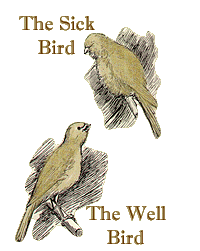
![]() Illness
and Injury: The Unwell Bird
Illness
and Injury: The Unwell Bird
|
Birds are masters at hiding the signs of illness. They work hard to keep up a normal appearance as long as possible, so by the time major symptoms are showing they have usually been sick for awhile. We need to learn to look for the more subtle signs of illness in order to get a head start in correcting it. EARLY SIGNS OF ILLNESS:
These early symptoms may not require emergency medical treatment, but they are signs that something is going on and that your bird should be checked by your avian veterinarian. EVALUATING DROPPINGS: A bird's health is often reflected in its droppings Learn what normal droppings look like and observe your bird on a daily basis for changes or abnormalities. SIGNS OF SERIOUS ILLNESS:
These symptoms can be the result of a serious health problem and need immediate veterinary help. Provide supportive care for the bird in the form of warmth and nourishment until you can reach your vet. |
 |
HEALTH
| BASIC CARE | ILLNESS
AND INJURY | SYSTEMS | FEATHER
PROJECT | TAMBOPATA | VAL
| LINKS
AVIAN VET | CHECK-UP
| DROPPINGS | DIAGNOSTICS
| EMERGENCIES | COMMON
INJURIES | CPR | WEST
NILE VIRUS
| IMMUNE | REPRODUCTION
DIET | ENVIRONMENT
©
kgsmith 2011
No content may be used or reproduced without the author's written permission
DO NO HARM